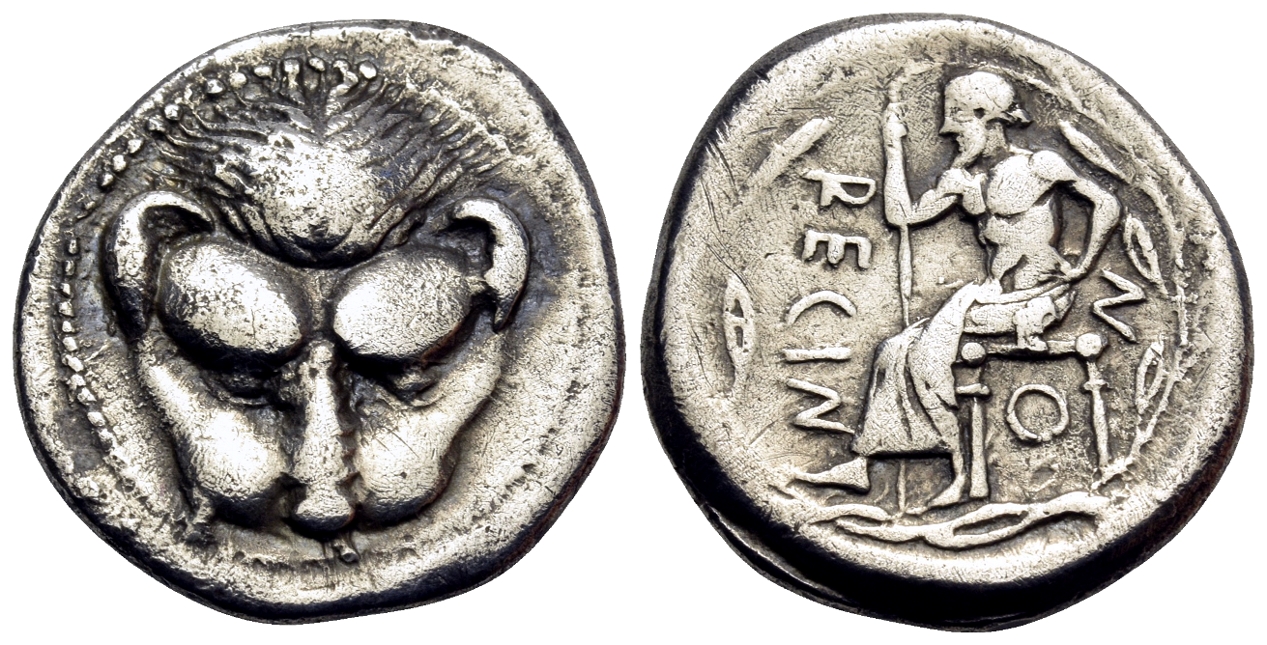Rhegium, silver, drachms (466-415 BCE)
From SILVER
466 BCE - 415 BCE Silver 1,382 kg
Description
| ObverseInscription or printing placed on the obverse.: | Lion's mask facing, border dots |
| ReverseInscription or printing placed on the reverse.: | PECINON (Greek).Iokastos, bearded and draped from the waist, seated left on backless stool, holding long scepter in his right hand and left resting on hip, all within olive wreath. |
Mint and issuing power
| MintIdentifies the place of manufacture or issue of a numismatic object.: | Rhegium | Ancient regionAncient region.: | Bruttium | Modern countryModern country: Italy | AuthorityIdentifies the issuing power. The authority can be "pretended" when the name or the portrait of X is on the coin but he/she was not the issuing power. It can also be "uncertain" when there is no mention of X on the coin but he/she was the issuing power according to the historical sources: |
Chronology
| FromIdentifies the initial date in a range assigned in a numismatic context. | 466 BCE | toIdentifies the final date in a range assigned in a numismatic context.. | 415 BCE | PeriodTime period of the numismatic object.: Classical 480-323 BC |
Physical description
| MetalThe physical material (usually metal) from which an object is made.: | Silver |
Median weightMedian of the weights of numismatic objects (in grams). in grams | 4.10 | DenominationTerm indicating the value of a numismatic object. Examples: tetradrachm, chalkous, denarius.: | drachma |
StandardStandard.: |
Image

AC 35 - Rhegium, silver, drachma, 466-415 BC.jpg [1]
References
| Die study referencePublication of the study: | Herzfelder 19571Herzfelder 1957, first series | ||
| Coin series referenceReference to coin series study: | Sear I2Sear I, n° 501, RQEMAC3RQEMAC, n° 35, HN Italy4HN Italy, n° 2478, HGC 15HGC 1, n° 1643 | ||
| Coin series web referenceCoin series web references: | |||
Obverse dies distribution
| FrequencyFrequency of specimen in distribution. ᵖ | Number of obversesNumber of obverse dies. ᵖ (o) | % (o) | Number of coinsNumber of coins. (n) | % (n) | Die nameName(s) of the die(s). |
| 1 | 1 | 6.25 | 1 | 0.88 | 11 |
| 2 | 2 | 12.5 | 4 | 3.54 | 25, 26 |
| 3 | 2 | 12.5 | 6 | 5.31 | 13, 14 |
| 5 | 2 | 12.5 | 10 | 8.85 | 16, 17 |
| 6 | 1 | 6.25 | 6 | 5.31 | 24 |
| 7 | 2 | 12.5 | 14 | 12.39 | 7, 33 |
| 8 | 2 | 12.5 | 16 | 14.16 | 6, 12 |
| 9 | 1 | 6.25 | 9 | 7.96 | 10 |
| 11 | 1 | 6.25 | 11 | 9.73 | 8 |
| 16 | 1 | 6.25 | 16 | 14.16 | 9 |
| 20 | 1 | 6.25 | 20 | 17.7 | 15 |
| Total | 16 of 16 | 100 | 113 of 113 | 99.99 |
Reverse dies distribution
no distribution is available
Quantification
| Number of obversesNumber of obverse dies. ᵖ (o) | 16 | Number of singletons (o1)The number of singleton coins. ᵖ | 1 |
| Number of reverse diesNumber of reverse dies. (r) | 19 | Number of coinsNumber of coins. (n) | 113 |
| Coins per obverse dieNumber of coins per obverse die. (n/o) | 7.06 | Coins per reverse dieNumber of coins per reverse die. (n/r) | 5.95 |
| Reverse per obverse ratioRatio of obverse dies divided by reverse dies. (r/o) | 1.19 | Percentage of singletons (o1)number of coins (n) divided by the number of singletons (o1) ᵖ | 6.25 % |
| Original number of dies (O) (Carter 1983 formula)The estimation of the number of coins according to Carter 1983 ᵖ | 16.85 | Coins struck if 20,000 as average productivity per dieCoins made if the average productivity for obverses (according to Carter) is 20,000. ᵖ | 337,000 |
| Original number of dies (O) (Esty 2011 formula)The estimation of the number of coins according to the singleton formula in Esty 2011 ᵖ (O) | 18.64 | Survival rate if 20,000 as average productivity per dieSurvival rate if average productivity is 20,000. ᵖ | 0.00034 |
| Coverage (o = % of O) (Esty 1984 formula)Esty 1984 - coverage (% of O) ᵖ (o = % of O) | 99.12% | Die productivity if survival rate 1/2,000Average productivity if survival rate is 1/2,000. ᵖ | 13,412.46 |
| Weight of silver (in kg) if 20,000 coins per die (O = Carter formula)Carter 1983 * Median weight * 20000 (*10 if gold or electrum) ᵖ | 1,382 kg <br /> 1,382 kg | Die productivity if survival rate 1/5,000Average productivity if survival rate is 1/5,000. ᵖ | 33,531.16 |
Remarks